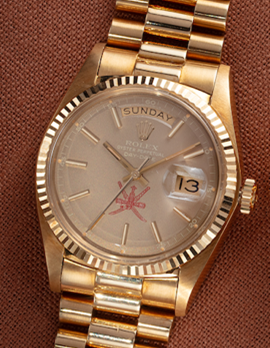Rolex and Patek Philippe “Arabic Dial” Watches at Christie’s Dubai Edit
Middle Eastern signifiers embodied in the finest watch design and craftsmanship offered in Christie’s Watches Online: The Dubai Edit 5 – 19 October 2023 | 164 lots | low estimate: US$ 7.6 million.
Dubai, 25 September 2023 – As part of Watches Online: The Dubai Edit, held by Christie’s Middle East’s from 5 to 19 October 2023, highlights will include:
- a major ensemble of “Arabic dial” watches, day-date Rolexes, consigned by an important client, including timepieces gifted by the late Sultan Qaboos Bin Said Al Said
- a stunning Patek Phillipe Ref. 5077, one of only 20 ever made, depicting an enamel dial with a miniature painting of two Arab huntsmen engaged in the art of falconry
Remy Julia, Head of Watches Christie’s Middle East, India & Africa: “It's not often you see a collector with such a keen eye for unique and spectacular gem-set watches. The collection is very diverse - from vintage Rolex Day-Dates retailed by Asprey and commissioned by the late Sultan Qaboos Bin Said Al Said, the former ruler of Oman, to more contemporary rarities such as the unique Harry Winston Opus 7 with a gem-set bezel. Not forgetting the incredible one-off Patek Philippe Ref. 3843/1. The consigners love of grand complications is evident in the three watches of the Girard-Perregaux Opera trilogy and the Breguet Ref. 3857 perpetual calendar minute repeater. It is a nuanced and well-organised collection that has taken considerable time and effort to curate.”
Lot 28 – This fine and rare Rolex, day-date Ref. 1803/8 in yellow gold has the signature of the late Sultan Qaboos Bin Said Al Said, the ruler of Oman from 1970 to 2020. The blue dial presents the signature “Qaboos” in red print. Retailed by Asprey, its date of manufacture is circa 1974. (Est. US$35,000-55,000)
Lot 24 – A Rolex, day-date Ref. 1803 in yellow gold, with blue dial and red ‘Khanjar’ logo – the national emblem of the Sultanate of Oman. Retailed by Asprey, its date of manufacture is circa 1974. (Est. US$35,000-55,000)
Gulf royalty and high-ranking officials in the Middle East often commissioned watches with their name or logo on the dial. These watches were given as state gifts or commemorative tokens to VIPs, diplomats or business partners. In the esoteric world of watch collecting, these “Arabic dial” watches were considered more interesting to collect than the regular-production versions. The late Sultan Qaboos Bin Said Al Said, a man with undeniably exquisite taste and a passion for watchmaking, owned and gave as gifts countless such timepieces. Depending on the level and importance of the occasion, gifts of a “horological nature” ranged from a simple timepiece to a stunning Rolex or Patek Philippe timepiece. The two timepieces above bear the engraving 'Asprey' on the caseback. In addition to the standard engravings of the manufacturer, the serial number is engraved above the reference number. This feature is typical of special orders, in these cases from the prestigious London retailer Asprey in the 1970s.
Lot 26 – A Rolex, day-date Ref. 1802 in yellow gold, with a silver dial with applied hour markers and ‘Qaboos’ signature in red print transfer – a reference to Sultan Qaboos Bin Said Al Said, the former ruler of Oman. The caseback is engraved K.R., the initials of Khimji Ramdas, the Rolex retailer in Oman. Circa 1974. (Est. US$35,000-55,000)
Lot 22 – A Rolex, day-date Ref. 1803 in yellow gold, with a taupe dial with applied hour markers and red Khanjar logo – the national emblem of Oman. The caseback is engraved K.R., the initials of Khimji Ramdas, the Rolex retailer in Oman. Circa 1974. (Est. US$35,000-55,000)
Lot 03 – one of only 20 made: a platinum Patek Philippe Ref. 5077P-091 presenting an enamel dial with a miniature painting of two Arab huntsmen engaged in the art of falconry.
Each year, Patek Philippe introduces a selection of dials with a variety of themes to showcase various arts such as enamelling, miniature painting and marquetry. The dial on this platinum variant of the Calatrava Ref. 5077, first commercialised in 2007, serves as the canvas for an enamel creation inspired by the works of Orientalist painters such as Georges Washington, Henri Émilien Rousseau, and Eugène Fromentin.
Rich in detail, the miniature painting portrays two Arab horsemen about to go hunting with a falcon. Falconry has been an integral part of the culture of the Arabian Peninsula for thousands of years. Well-trained falcons were essential to the Bedouin's survival in the harsh and resource-scarce desert environment. Although conventional hunting of animals or birds is subject to stringent restrictions in much of the Arab world, and in some places banned outright, falconry thrives as the 'sport of kings' and remains a popular pastime for the wealthy elite throughout the Gulf region. Today, trained birds of prey are considered status symbols and often feature on emblems of arms of Arab institutions. (Est.: US$150’000-250’000)







Comments
Leave a comment